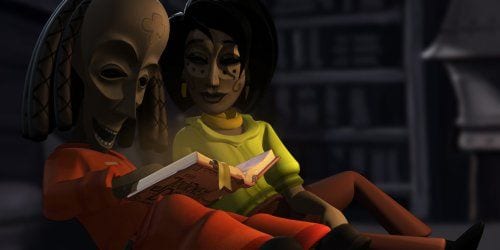
The Journey Down: Chapter One is the labour of love of Swedish indie developer Skygoblin. The whole project is drenched in indie style and direction, and in a perfect world, many of its best ideas hopefully will filter through to the mainstream market. At just over two hours of gameplay, it’s just a flicker of a game, but it’s brilliant enough and leaves behind an appealing ghost when it’s finished.
The game takes place in the grimy district of Kingsport Bay, a small, communal dock on the outskirts of St. Armando. In the opening cutscene, we see two gangster caricatures ransack a professor’s office looking for a mysterious book. Cut to the Gas’n’Charter station where the hero, a pilot named Bwana, makes a living pumping gas with his brother and mechanic, Kito. Enter the scholarly Lina, who has tracked the book to humble Kingsport, asking for help in looking for the specific location of the book and for a discrete flight out of St. Armando. With Bwana and Kito fighting a losing battle against their electric company, they’re more than happy to accept Lina’s somewhat suspicious business.
The bare bones of the adventure genre — finding keys and then finding locks — is close to perfectly demonstrated in The Journey Down. The interface is so intuitive that the game doesn’t even need a tutorial. The first few puzzles tell the player all they need to know about how to play, while also introducing the setting and characters. The game is never easy, but it’s also never frustrating either. Solving each puzzle feels rewarding because they’re creative and challenging, without paralyzing the player with infinite variables. The game’s short length and limited locations make it easy to slip out of most logjams without surrendering to a walkthrough. Still, Bwana will occasionally solve a puzzle before the player and offer a hint that’s a little too helpful, but the help is more often appreciated than insulting. As competent as it is as a game, for less than three hours of play, most of its appeal lies in its aesthetics.
At first the animation seems a little spotty, and it takes a while to adjust to the skeletal character designs. However, The Journey Down is very distinct and stylish without relying on a heavier game engine. Though, as great as it is when a developer is able to be creative within their limitations, the character designs never totally stop coming off as a little creepy. That said, this design choice is not a deal breaker. Also, Simon De Souza’s music contributes enormously to the unique experience that is The Journey Down. Most of the game’s personality comes from the often warm, occasionally haunting, always captivating jazz music.
The game’s cast is similarly charming. The happy-go-lucky Bwana seems as motivated by having something to do as he is to make ends meet. Throughout the game, the player guides Bwana through Kingsport looking for the book for Lina as well as engine parts so that Kito can rebuild the plane. Bwana just seems content to have something to do. Visiting the inhabitants of Kingsport along the way offers a great slice-of-life picture of the world and the steady pace at which the surprisingly complex world is built never feels overwhelming or unnatural. Some of Bwana’s exposition feels a little forced, but Anthony Sardinha’s exuberant voice acting breathes a lot of life into the character. At times, Sardinha’s delivery is all that saves the game from a few frankly abysmal voice performances. Still, the writing is simple but solid, and the characters are lively enough to forgive a few flat deliveries. Kito and Lina feel a little underused, but presumably they’ll have more of the spotlight in later chapters of the journey.
It’s also worth mentioning that aside from a single slightly blanched French maître d’ none of the characters are white. It could be that St. Armando and Kingsport Bay are overtly inspired by a Caribbean aesthetic or possibly because it’s so rare in games that choosing not to feature any white characters was just something new to try. Either way, it is refreshing to see non-token characters of color. That said, the sense of progressiveness is arrested as soon as an Asian chef bemoans that a ruined dish threatens to ruin his honor.
Finally, the cold cost-benefit analysis at the end of the day hinges on the episodic plan for The Journey Down. Releasing games in short episodes designed to be finished in a weekend or even a sitting is a good model for some games, especially indie games whose developers need to live hand-to-mouth on whatever they can get after just a few months in production. Even for The Journey Down, an episodic release schedule could possibly work. But after the first chapter, all that’s established is the main cast and a small part of an apparently large world. The game doesn’t even tell us what it is Lina and the gangsters that are chasing her are after. The entire episode is all setup and no plot. With such a short game and no real sense of direction when it’s over with, it bodes ill for the pacing of the rest of the saga. Even so, it’s about $8 spent on a game that is good.
The Journey Down probably won’t make anybody swoon — not until later chapters help establish some context — but there’s little to complain about. As far as adventure games go, it’s a pretty good standard to go on. It has a vivacious personality, even though there really isn’t quite enough content to really get attached to. Doing nothing wrong may not be the same thing as getting everything right, but it’s not a bad way to start: likewise The Journey Down: Chapter One is not a bad start either.

![Call for Papers: All Things Reconsidered [MUSIC] May-August 2024](https://www.popmatters.com/wp-content/uploads/2024/04/all-things-reconsidered-call-music-may-2024-720x380.jpg)



